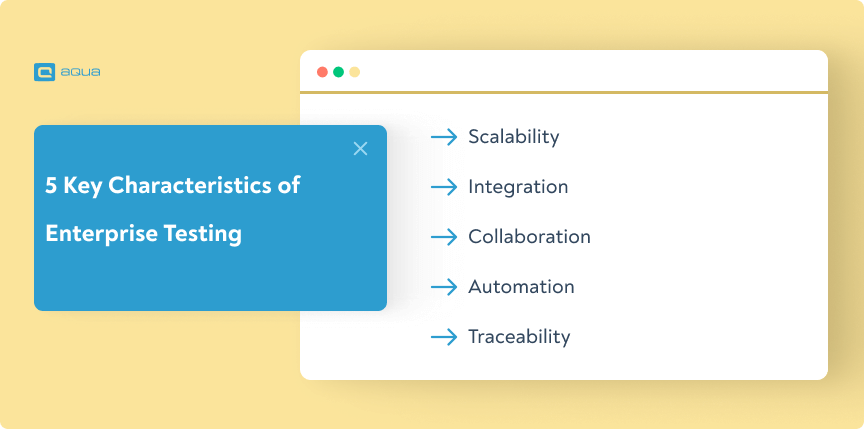What is enterprise testing?
Enterprise testing is the process of evaluating software applications within large organisations. The goal is the same with the concept of standard testing: to ensure the product meets the specified requirements and function correctly, but in complex environments. In simple terms, it’s about verifying that the software works smoothly across different systems, teams, and technologies.
“The bitterness of poor quality remains long after the sweetness of low price is forgotten.”
Benjamin Franklin
Key characteristics of enterprise testing:
- Scalability: Supports large-scale applications with multiple users and functions.
- Integration: Ensures tools and processes work together across various platforms.
- Collaboration: Involves different teams to promote shared ownership of quality.
- Automation: Leverages automated testing to improve efficiency and reduce manual errors.
- Traceability: Tracks requirements through testing to ensure alignment with business objectives.

Combine these, and you will have the predetermined formula in your mind. But it is not yet a strategy. So let’s build it together.
The most important components of an effective enterprise testing strategy
So what makes an enterprise testing strategy robust? On your way to deliver quality software, understanding the core components will make all the difference. Let’s look at the most important ones that make up the perfect enterprise testing strategy:
- Comprehensive Test Coverage: Test all critical areas, including functional, performance, and security aspects.
- Risk Management: Identify and prioritise risks to focus testing efforts on the most impactful areas.
- Continuous Integration/Continuous Deployment (CI/CD): Integrate testing into the CI/CD pipeline for faster feedback and quicker releases.
- Clear Metrics and Reporting: Define success criteria and measure progress to identify improvement areas.
- Training and Skill Development: Invest in your team’s skills to adapt to new tools and methodologies.
Now, what challenges are you going to face, when trying to combine these characteristics together? Let’s break them down for you.
Challenges in enterprise testing
This is probably the most relatable part of our guide: the challenges. Even if you are a strict professional that stick to the rules all the time, there will be various struggles that harm your enterprise testing efforts. Recognising these hurdles is the first step toward overcoming them:
- Chaotic Teams: In an enterprise, different departments often operate independently. This leads to miscommunication and subpar testing efforts.
- Complex Environments: Multiple legacy systems and technologies complicate integration and increase testing efforts. Soon you find yourself wondering what is the next step in this chaos.
- Resource Constraints: From time to time, limited budgets and staffing can restrict the effectiveness of testing efforts. We will provide the solution for this in the next section.
- Rapid Changes: The fast pace of development can make it difficult to keep up with testing requirements.
- Tool Fragmentation: Using too many different tools simultaneously leads to inefficiencies and even more problems. You want to fix one thing, but end up breaking another.
If you consider these challenges and focus on the key components, you can build a strong foundation for enterprise testing. However, you will need QA testing tools massively in the process.
What if we told you there is a way you can overcome these challenges simultaneously and efficiently? Let us introduce aqua cloud – the first AI-powered test management solution that will streamline all your enterprise testing efforts. How?
Bringing German quality and precision to software testing, aqua is the ultimate enterprise testing tool because of the following:
- Perfect collaboration: A central repository for all testing activities, AND a native integration Capture, 1-click bug recording tool, will make sure everyone is on the same page.
- Advanced Analytics and KPIs: Access to powerful analytics and real-time dashboards to gain insights into testing performance and identify areas for improvement.
- Saving lots of money and time: With aqua’s AI-powered generative features, you reduce manual efforts and save a staggering 98% of your time.
- 100% Scalability: aqua is designed to grow with your organisation, matching your increasing enterprise testing demands without compromising performance.
- Streamlined CI/CD Integration: You can integrate aqua seamlessly with various popular automation and project management tools, including Jira, Jenkins and Selenium, to trigger CI/CD and test automation jobs directly from your test cases.
Just a click to experience the new era of enterprise testing in seconds.
Save thousands of dollars in enterprise testing through an AI-powered solution
Think choosing enterprise QA tools is just about comparing features? Try this interactive challenge where you’ll face 6 real decisions as a QA Director, each one revealing hidden complications, budget pressures, and stakeholder politics you didn’t see coming.
You've just been hired as QA Director at a mid-sized enterprise scaling rapidly.
Your Challenge: Build the QA toolchain. But here's the catch—every decision unlocks new complications you didn't see coming.
The Reality: Enterprise tool selection isn't about features. It's about stakeholders, compliance, politics, and surprises.
📋 Your Company Profile
👥
Team: 45 engineers, 8 QA
🏢
Industry: FinTech
🌍
Locations: US, EU, APAC
💰
Budget: $150K/year
⚖️
Compliance: SOC 2, GDPR
🔧
Legacy: Monolith + Microservices
Best strategies for integrating QA tools in enterprise environments
You need a strategy for integrating QA tools in your enterprise environments. As every step you take might cost you lots of time and money, you need to craft this strategy carefully. But don’t worry, because we already did it for you. The only thing you should do is just follow this plan combined with the solution we provide.
1. Create Clear Communication Channels
Effective integration begins with communication. Make sure all teams involved in the testing process are aligned and informed. Regular meetings and updates can help maintain transparency. For instance, implementing daily stand-ups can keep everyone on the same page and quickly address any issues that arise. Encourage a collaborative environment where development and QA teams work closely together. When teams share responsibilities and insights, they become more invested in the success of the project.
2. Centralise Test Management
A centralised test management system helps you keep track of all testing activities in one place. This will enhance visibility and streamline collaboration among your teams. Being able to access all your test cases, requirements, and results from a single dashboard— will be a life-saver, keeping you from the chaos of managing multiple tools.
3. Prioritise Automation
Automating repetitive tasks allows your team to focus on more complex testing scenarios. This is really crucial as software testing also follows the Pareto principle: you can find the 80% of the most critical bugs by just focusing on the 20% most critical areas. By integrating automation tools, you will reduce human error and accelerate the testing process, so you can focus on these areas without any pressure.
4. Implement Continuous Testing
Prioritising continuous testing into your CI/CD pipeline means that testing is done at every stage of development. This way, you ensure quicker feedback and earlier detection of defects. As a result, you can catch issues before they escalate, leading to a smoother release process.
5. Analyse Your Data
Using data analytics can provide valuable insights into your testing process. By analysing trends and patterns, you can identify areas that need improvement. For example, if you notice a recurring bug in a specific module, you can prioritise it for more in-depth testing. This will ultimately reduce the risk in your software delivery.
6. Choose the Right Tools
Selecting the right QA tools is crucial for successful integration. Look for tools that align with your team’s needs and work well with existing systems. Opt for solutions that offer flexibility and scalability to adapt to your growing requirements.
And this is where aqua cloud – an AI-powered TMS comes into play – with its traceability, flexibility, and scalability, all together. Aiming at just one thing: taking away the pain of testing, aqua is here to save your enterprise environments from chaos.
This is how you can achieve it with aqua:
- Enhanced Traceability: Keep projects aligned effortlessly with 100% traceability.
- Flexibility in Integration: Adapt to your tools seamlessly, whether it is Selenium, Jenkins, Ranorex, Jira or others.
- Scalable Solutions: Grow with your needs, with a solution that provides 100% scalability.
- Time Savings: Reduce manual testing efforts and save 98% of your time with generative AI-powered features.
- Improved Collaboration: Have the most visually appealing bug tracking with Capture integration.
- Comprehensive Reporting: Gain insights quickly and easily, and customise the reports to your needs.
aqua is the ultimate solution for enterprise testing efforts. The only question is, are you ready to deliver the deserved quality to your enterprise?
Growing needs? Then you need a 100% scalable solution!
Conclusion
Integrating QA tools into enterprise environments is not easy: it requires multi-step approach. By following the strategies we mentioned above, you can overcome common challenges and have a breath of fresh air in the middle of chaos.
And as you learned, selecting the right tool will create a more effective testing ecosystem. Having a robust solution like aqua will feel like you have 10 more professionals in your team. Focus on building a quality-centric approach with the right solution, and you’ll pave the way for successful software delivery.



















